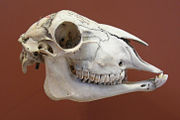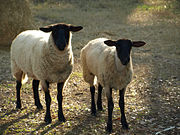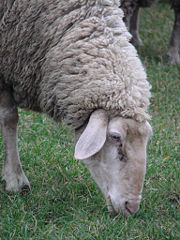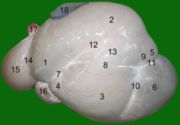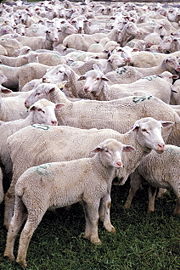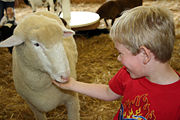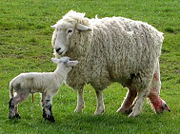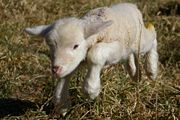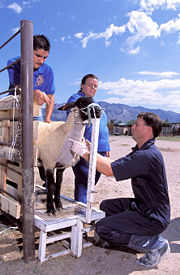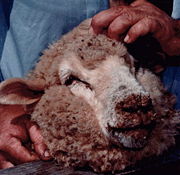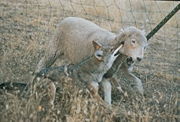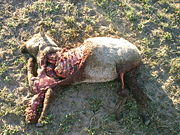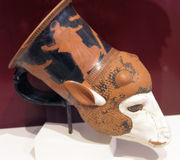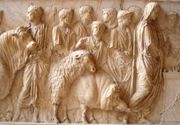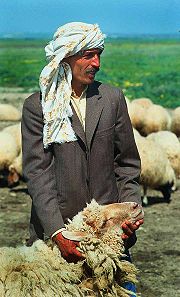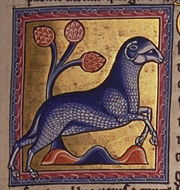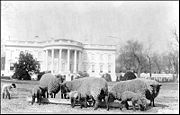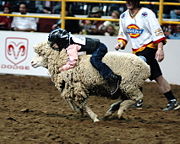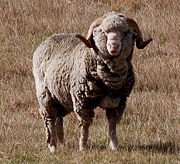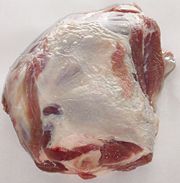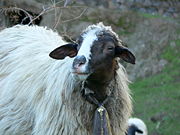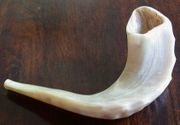Domestic sheep
2008/9 Schools Wikipedia Selection. Related subjects: Mammals
| Domestic sheep | ||||||||||||||||
|---|---|---|---|---|---|---|---|---|---|---|---|---|---|---|---|---|
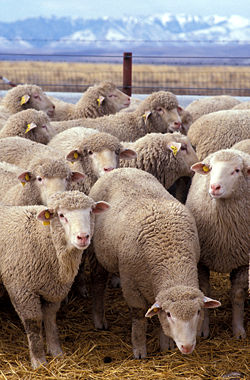 A research flock at US Sheep Experiment Station near Dubois, Idaho
|
||||||||||||||||
| Conservation status | ||||||||||||||||
|
Domesticated
|
||||||||||||||||
| Scientific classification | ||||||||||||||||
|
||||||||||||||||
| Binomial name | ||||||||||||||||
| Ovis aries Linnaeus, 1758 |
Domestic sheep (Ovis aries) are quadrupedal, ruminant mammals kept as livestock. Like all ruminants, sheep are even-toed ungulates, also commonly called cloven-hoofed animals. Although the name sheep applies to many species, in everyday usage it almost always refers to Ovis aries. Domestic sheep are the most numerous species in their genus, and are most likely descended from the wild mouflon of Europe and Asia.
One of the earliest animals to be domesticated for agricultural purposes, sheep are primarily valued for their fleece and meat. A sheep's wool is the most widely used of any animal, and is typically harvested by shearing. Ovine meat is called lamb when from younger animals and mutton when from older ones. They continue to be important for wool and meat today, and are also occasionally raised for pelts, as dairy animals, or as model organisms for science.
Sheep husbandry is practised throughout the inhabited world, and has played a pivotal role in many civilizations. In the modern era, Australia, New Zealand, Patagonian nations, and the United Kingdom are most closely associated with sheep production. Sheep-raising has a large lexicon of unique terms which vary considerably by region and dialect. Use of the word sheep began in Middle English as a derivation of the Old English word scēap; it is both the singular and plural name for the animal. A group of sheep is called a flock, herd or mob. Adult female sheep are referred to as ewes, intact males as rams, castrated males as wethers, and younger sheep as lambs. Many other specific terms for the various life stages of sheep exist, generally related to lambing, shearing, and age.
Being a key animal in the history of farming, sheep have a deeply entrenched place in human culture, and find representation in much modern language and symbology. As livestock, sheep are most-often associated with pastoral, Arcadian imagery. Sheep figure in many mythologies—such as the Golden Fleece—and major religions, especially the Abrahamic traditions. In both ancient and modern religious ritual, sheep are used as sacrificial animals. In contemporary English language usage, people who are timid, easily led, or stupid are often compared to sheep.
Etymology
Etymologically, the word modern English language speakers now use to denote ovines is derived from the Old English term scēap, which is akin to the Old High German scāf and probably ultimately originated from Proto-Germanic or Gothic. Before 1200 AD, English spelling preferred scheap, and the shift to the currently used spelling did not occur until about 1280.
The word ram derives from the Old English rom (dated to 725) and subsequently ramm (in use before 1325). The word has always been closely associated with implements used in the application of force, such as the battering ram or the weight of a pile driver, but its earliest usage is in reference to male sheep. Before 1300, ewe was usually written as ouwe, and it stems from the Old English ēowu. Lamb is thought to be the oldest ovine term still used in an unchanged form; its first appearance is in 858. It sprang from the Old English lomb (dated to 725), and the verb form is first recorded from 1611.
Description
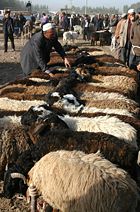
Domestic sheep are relatively small ruminants, typically with horns forming a lateral spiral and crimped hair called wool. Domestic sheep differ from their wild relatives and ancestors in several respects, having become uniquely neotenic as a result of man's influence. A few primitive breeds of sheep retain some of the characteristics of their wild cousins, such as short tails. Depending on breed, domestic sheep may have no horns at all (polled), or horns in both sexes (as in wild sheep), or in males only. Most horned breeds have a single pair.
Another trait unique to sheep are their wide variation in colour. Wild sheep are largely variations of brown hues. Colors of domestic sheep range from pure white to dark chocolate brown and even spotted or piebald. Selection for easily dyeable white fleeces began early in sheep domestication, and as white wool is a dominant trait it spread quickly. However, colored sheep do appear in many modern breeds, and may even appear as a recessive trait in white flocks. While white wool is desirable for large commercial markets, there is a niche market for colored fleeces, mostly for handspinning.
Depending on breed, sheep show a range of heights and weights. Their rate of growth and mature weight is a heritable trait that is often selected for in breeding. Ewes typically weigh between 100 and 225 pounds (45–100 kg), with the larger rams between 100 and 350 pounds (45–160 kg). Mature sheep have 32 teeth ( dental formula: I:0/4 C:0/0 P:3/3 M:3/3). As with other ruminants, the eight incisors are in the lower jaw and bite against a hard, toothless pad in the upper jaw; picking off vegetation. There are no canines, instead there is a large gap instead between the incisors and the premolars. Until the age of four (when all the adult teeth have erupted), it is possible to see the age of sheep from their front teeth, as a pair of incisors erupts each year.
The front teeth are gradually lost as sheep age, making it harder for them to feed and hindering the health and productivity of the animal. For this reason, domestic sheep on normal pasture begin to slowly decline from four years on, and the average life expectancy of a sheep is 10 to 12 years, though some sheep may live as long as 20 years.
Sheep have good hearing, and are sensitive to noise when being handled. Sheep have horizontal slit-shaped pupils, possessing excellent peripheral vision; with visual fields of approximately 270° to 320°, sheep can see behind themselves without turning their heads. However, sheep have poor depth perception; shadows and dips in the ground may cause sheep to balk. In general, sheep have a tendency to move out of the dark and into well-lit areas. Sheep also have an excellent sense of smell, and—like all species of their genus—have scent glands just in front of the eyes, and interdigitally on the feet. The purpose of these glands is uncertain, but those on the face may be used in breeding behaviors. The interdigital glands might also be used in reproduction, but alternative reasons, such as secretion of a waste product or a scent marker to help lost sheep find their flock, have also been proposed.
Sheep and goats are closely related (both are in the subfamily Caprinae), and it can be difficult to distinguish them by their appearance. However, they are separate species, so hybrids rarely occur, and are always infertile. A hybrid of a ewe and a buck (a male goat) is called a sheep-goat hybrid, and is not to be confused with the genetic chimera called a geep. Visual differences between sheep and goats include the beard and divided upper lip unique to goats. Sheep tails also hang down, even when short or docked, while the tails of goats are held upwards. Sheep breeds are also often naturally polled (either in both sexes or just in the female), while naturally polled goats are rare (though many are polled artificially). Males of the two species differ in that buck goats acquire a unique and strong odour during the rut, whereas rams do not.
Breeds
The domestic sheep is a multi-purpose animal, and the more than 200 breeds now in existence were created to serve these diverse purposes. Some sources give a count of a thousand or more breeds, but these numbers cannot be verified. Almost all sheep are classified as being best suited to furnishing a certain product: wool, meat, milk, hides, or a combination in a dual-purpose breed. Other features used when classifying sheep include face colour (generally white or black), tail length, presence or lack of horns, and the topography for which the breed has been developed. This last point is especially stressed in the UK, where breeds are described as either upland (hill or mountain) or lowland breeds. A sheep may also be of a fat-tailed breed, which is a dual-purpose sheep common in Africa and Asia with larger deposits of fat within its tail.
Breeds are also grouped based on how well they are suited to producing a certain type of breeding stock. Generally, sheep are thought to be either "ewe breeds" or "ram breeds". Ewe breeds are those that are hardy, and have good reproductive and mothering capabilities—they are for replacing breeding ewes in standing flocks. Ram breeds are selected for rapid growth and carcass quality, and are mated with ewe breeds to produce meat lambs. Lowland and upland breeds are also crossed in this fashion, with the hardy hill ewes crossed with larger, fast-growing lowland rams to produce ewes called mules, which can then be crossed with meat-type rams to produce prime market lambs. Many breeds, especially rare or primitive ones, fall into no clear category.
Breeds are categorized by the type of their wool. Fine wool breeds are those that have wool of great crimp and density, which are preferred for textiles. Most of these were derived from Merino sheep, and the breeds continues to dominate the world sheep industry. The record for the most valuable sheep belongs to an Australian Merino ram that was sold for $16,000 AUD. Medium wool breeds have wool between the extremes, and are typically fast-growing meat and ram breeds with dark faces. Some major medium wool breeds, such as the Corriedale, are dual-purpose crosses of long and fine-wooled breeds and were created for high-production commercial flocks. Long wool breeds are the largest of sheep, with long wool and a slow rate of growth. Long wool sheep are most valued for crossbreeding to improve the attributes of other sheep types. For example: the American Columbia breed was developed by crossing Lincoln rams (a long wool breed) with fine-wooled Rambouillet ewes.
Coarse or carpet wool sheep are those with a medium to long length wool of characteristic coarseness. Breeds traditionally used for carpet wool show great variability, but the chief requirement is a wool that will not break down under heavy use (as would that of the finer breeds). As the demand for carpet-quality wool declines, some breeders of this type of sheep are attempting to use a few of these traditional breeds for alternative purposes. Others have always been primarily meat-class sheep.
A minor class of sheep are the dairy breeds. Dual-purpose breeds that may primarily be meat or wool sheep are often used secondarily as milking animals, but there are a few breeds that are predominantly used for milking. These sheep do produce a higher quantity of milk and have slightly longer lactation curves. In the quality of their milk, fat and protein content percentages of dairy sheep vary from non-dairy breeds but lactose content does not.
A last group of sheep breeds is that of fur or hair sheep, which do not grow wool at all. Hair sheep are similar to the early domesticated sheep kept before woolly breeds were developed, and are raised for meat and pelts. Some modern breeds of hair sheep, such as the Dorper, result from crosses between wooled and hair breeds. For meat and hide producers, hair sheep are cheaper to keep, as they do not need shearing. Hair sheep are also resistant to parasites and hot weather.
With the modern rise of corporate agrobusiness and the decline of localized family farms, many breeds of sheep are in danger of extinction. The Rare Breeds Survival Trust of the UK lists 25 native breeds as having only 3,000 registered animals, and the American Livestock Breeds Conservancy lists 14 as having fewer than 10,000. Preferences for breeds with uniform characteristics and fast growth have pushed heritage (or heirloom) breeds to the margins of the sheep industry. Those that remain are maintained through the efforts of conservation organizations, breed registries, and individual farmers dedicated to their preservation.
Diet
Sheep are exclusively herbivorous mammals. Like all ruminants, sheep have a complex digestive system composed of four chambers, allowing them to break down cellulose from stems, leaves, and seed hulls into simpler carbohydrates. When sheep graze, vegetation is chewed into a mass called a bolus, which is then passed into the first chamber: the rumen. The rumen is a 5- to 10-gallon (19–38 l) organ which ferments feed via a symbiotic relationship with the bacterium, protozoa, and yeasts of the gut flora. The bolus is periodically regurgitated back to the mouth as cud for additional chewing and salivation. Cud chewing is an adaptation allowing ruminants to graze more quickly in the morning, and then fully chew and digest feed later in the day. This is beneficial as grazing, which requires lowering the head, leaves sheep vulnerable to predators, while cud chewing does not.
During fermentation, the rumen produces gas that must be expelled; disturbances of the organ, such as sudden changes in a sheep's diet, can cause potentially fatal conditions such as bloat. After fermentation in the rumen, feed passes in to the reticulum and the omasum; special feeds such as grains may bypass the rumen altogether. Following the first three chambers, food moves in to the abomasum for final digestion before processing by the intestines. The abomasum is the only one of the three chambers analogous to the human stomach (being the only one that absorbs nutrients for use as energy), and is sometimes called the "true stomach".
Sheep follow a diurnal pattern of activity, feeding from dawn to dusk, stopping sporadically to rest and chew their cud. Ideal pasture for sheep is not lawn-like grass, but an array of grasses, legumes and forbs. Types of land where sheep are raised vary widely, from pastures that are seeded and improved intentionally to rough, native lands. Common plants toxic to sheep are present in most of the world, and include (but are not limited to) oak and acorns, tomato, yew, rhubarb, potato, and rhododendron.
Sheep are largely grazing herbivores, unlike browsing animals such as goats and deer that prefer taller foliage. With a much narrower face, sheep crop plants very close to the ground and can overgraze a pasture much faster than cattle. For this reason, many shepherds use managed grazing, where a flock is rotated through multiple pastures, giving plants time to recover. Paradoxically, sheep can both cause and solve the spread of invasive plant species. By disturbing the natural state of pasture, sheep and other livestock can pave the way for invasive plants. However, sheep also prefer to eat invasives such as cheatgrass, leafy spurge, kudzu and spotted knapweed over native species such as sagebrush, making grazing sheep an effective way of restoring native pastures.
Other than forage, the other staple feed for sheep is hay, often during the winter months. The ability to thrive solely on pasture (even without hay) varies with breed, but all sheep can survive on this diet. Also included in most sheep's diets are minerals, either in a trace mix or in licks.
Naturally, a constant source of potable water is also a fundamental requirement for sheep. The amount of water needed by sheep fluctuates with the season and the type and quality of the food they consume. When sheep feed on large amounts of new growth and there is precipitation (including dew, as sheep are dawn feeders), sheep need less water. When sheep are confined or are eating large amounts of cured hay, more water is typically needed. Sheep also require clean water, and may refuse to drink water that is covered in scum or algae.
Sheep are one of the few livestock animals raised for meat today that have never been widely kept in an intensive, confined animal feeding operation. Although there is a growing movement advocating alternative farming styles, a large percentage of beef cattle, pigs, and poultry are still produced under such conditions. In contrast, only a few specific categories of sheep are regularly given high-concentration grain feed, much less kept in confinement. Where there is not enough pasture available or the pasture is not rich enough, sheep producers may fatten market lambs before slaughter (called "finishing"), sometimes in feedlots. Many sheep breeders flush ewes and rams with grain during breeding to increase fertility. Ewes are also flushed during pregnancy to increase birth weights, as 70% of a lamb's growth occurs in the last five to six weeks of gestation. Otherwise, only lactating ewes and especially old or infirm sheep are commonly provided with grain. Feed provided to sheep must be specially formulated, as most cattle, poultry, pig, and even some goat feeds contain levels of copper that are lethal to sheep. The same danger applies to mineral supplements such as salt licks.
Behaviour and intelligence
Sheep are prey animals with a strong gregarious instinct, and a majority of sheep behaviors can be defined in these terms. The dominance hierarchy of Ovis aries and its natural inclination to follow a leader to new pastures were the pivotal factors in it being one of the first domesticated livestock species. All sheep have a tendency to congregate close to other members of a flock, although this behaviour varies with breed. Farmers exploit this behaviour to keep sheep together on unfenced pastures and to move them more easily. Shepherds may also use sheepdogs in this effort, whose highly bred herding ability can assist in moving flocks. Sheep are also extremely food-oriented, and association of humans with regular feeding often results in sheep soliciting people for food. Those who are moving sheep may exploit this behaviour by leading sheep with buckets of feed, rather forcing their movements with herding.
In regions where sheep have no natural predators, none of the native breeds of sheep exhibit a strong flocking behaviour. Sheep can also become hefted to one particular local pasture (heft) so they do not roam freely in unfenced landscapes. Ewes teach the heft to their lambs, and if whole flocks are culled it must be retaught to the replacement animals.
Flock dynamics in sheep are as a rule only exhibited in a group of four or more sheep. Fewer sheep may not react as normally expected when alone or with few other sheep. For sheep, the primary defense mechanism is simply to flee from danger when their flight zone is crossed. Secondly, cornered sheep may attempt to leap at and ram threats to escape. This is particularly true for ewes with newborn lambs, and rams (hence the verb form of the word ram).
In displaying flocking, sheep have a strong lead-follow tendency, and a leader often as not is simply the first sheep to move. However, sheep do establish a pecking order through physical displays of dominance. Dominant animals are inclined to be more aggressive with other sheep, and usually feed first at troughs. Primarily among rams, horn size is a factor in the flock hierarchy. Rams with different size horns may be less inclined to fight to establish pecking order, while rams with similarly sized horns are more so.
Sheep become highly stressed when separated from their flock members. Sheep can also recognize faces, and are most at ease when with sheep of the same breed. They may also come to recognize individual animals of other species, including humans. Relationships in flocks tend to be closest among related sheep: in mixed-breed flocks same-breed subgroups tend to form, and a ewe and her direct descendants often move as a unit within large flocks.
Sheep are frequently thought of as extremely stupid animals. A sheep's herd mentality and quickness to flee and panic in the face of stress often make shepherding a difficult endeavor for the uninitiated. Despite these perceptions, a University of Illinois monograph on sheep found them to be just below pigs and on par with cattle in IQ, and some sheep have shown problem-solving abilities; a flock in Yorkshire, England found a way to get over cattle grids by rolling on their backs. If worked with patiently, sheep may learn their names, and many sheep are trained to be led by halter for showing and other purposes. Sheep have also responded well to clicker training. Very rarely, sheep are used as pack animals. Tibetan nomads distribute baggage equally throughout a flock as it is herded between living sites.
Reproduction
Sheep follow a similar reproductive strategy to other herd animals. A flock of ewes is generally mated by a single ram, who has either been chosen by a farmer or has established dominance through physical contest with other rams (in feral populations). Most sheep are seasonal breeders, although some are able to breed year-round. Ewes generally reach sexual maturity at six to eight months of age, and rams generally at four to six months. Ewes have estrus cycles about every 17 days, during which they emit a scent and indicate readiness through physical displays towards rams. A minority of sheep display homosexuality (8% on average) or are freemartins (female animals that are behaviorally masculine and lack functioning ovaries).
Without human intervention, rams fight during the rut to determine which individuals may mate with ewes. Rams, especially unfamiliar ones, will also fight outside the breeding period to establish dominance; rams can kill one another if allowed to mix freely. During the rut, even normally friendly rams may become aggressive towards humans due to increases in their hormone levels.
After mating, sheep have a gestation period of about five months, and normal labor may take one to three hours. Although some breeds may regularly throw larger litters of lambs, most produce single or twin lambs. During or soon after labor, ewes and lambs may be confined to small lambing jugs, small pens designed to aid both careful observation of ewes and to cement the bond between them and their lambs.
Ovine obstetrics can be problematic. By selectively breeding ewes that produce multiple offspring with higher birth weights for generations, sheep producers have inadvertently caused some domestic sheep to have difficulty lambing; balancing ease of lambing with high productivity is one of the dilemmas of sheep breeding. In the case of any such problems, those present at lambing may assist the ewe by extracting or repositioning lambs. After the birth, ewes ideally break the amniotic sac (if it is not broken during labor), and begin licking clean the lamb. Most lambs will begin standing within an hour of birth. In normal situations, lambs nurse after standing, receiving vital colostrum milk. Lambs that either fail to nurse or that are rejected by the ewe require aid to live, such as bottle-feeding or grafting on to another ewe.
After lambs are stabilized, lamb marking—the process of ear tagging, docking, and castrating—is carried out. Vaccinations are usually carried out at this point as well. Ear tags with numbers are attached for ease of later identification of sheep. Castration is performed on ram lambs not intended for breeding, although some shepherds choose to avoid the procedure for ethical, economic or practical reasons. Ram lambs that will either be slaughtered or separated from ewes before sexual maturity are not usually castrated. Docking, which is the shortening of a lamb's tail, is practiced for health reasons. Objections to all these procedures have been raised by animal rights groups, but farmers defend them by saying they solve many practical and veterinary problems, and inflict only temporary pain.
Health
Sheep may fall victim to poisons, infectious diseases, and physical injuries. As a prey species, a sheep's system is adapted to hide the obvious signs of illness, to prevent being targeted by predators. However, there are some obvious signs of ill health, with sick sheep eating little, vocalizing excessively, and being generally listless. Throughout history, much of the money and labor of sheep husbandry has aimed to prevent sheep ailments. Historically, shepherds often created remedies by experimentation on the farm. In countries including the United States, sheep lack the economic importance for drugs companies to perform expensive clinical trials to approve drugs for use with sheep. In such instances, shepherds resort to extra-label usage of drugs approved for other animals. In the 20th and 21st centuries, a minority of sheep owners have turned to alternative treatments such as homeopathy, herbalism and even traditional Chinese medicine to treat sheep veterinary problems. Despite some favorable anecdotal evidence, the effectiveness of alternative veterinary medicine has been met with skepticism in scientific journals. The need for traditional anti-parasite drugs and antibiotics is widespread, and is the main impediment to certified organic farming with sheep.
Many breeders take a variety of preventative measures to ward off problems. The first is to ensure that all sheep are healthy when purchased. Many buyers avoid outlets known to be clearing houses for animals culled from healthy flocks as either sick or simply inferior. This can also mean maintaining a closed flock, and quarantining new sheep for a month. Two fundamental preventative programs are maintaining good nutrition and reducing stress in the sheep. Handling sheep in loud, erratic ways causes them to produce cortisol, a stress hormone. This can lead to a weakened immune system, thus making sheep far more vulnerable to disease. Signs of stress in sheep include: excessive panting, teeth grinding, restless movement, wool eating, and wood chewing. Avoiding poisoning is also important, common poisons are pesticide sprays, inorganic fertilizer, motor oil, as well as radiator coolant (the ethylene glycol antifreeze is sweet-tasting).
A common form of preventative medication for sheep are vaccinations and treatments for parasites. Both external and internal parasites are the most prevalent malady in sheep, and are either fatal, or reduce the productivity of flocks. Worms are the most common internal parasites. They are ingested during grazing, incubate within the sheep, and are expelled through the digestive system (beginning the cycle again). Oral anti-parasitic medicines known as drenches are given to a flock to treat worms, sometimes after worm eggs in the feces has been counted to assess infestation levels. Afterwards, sheep may be moved to a new pasture to avoid ingesting the same parasites. External sheep parasites include: lice (for different parts of the body), sheep keds, nose bots, sheep itch mite, and maggots. Keds are blood-sucking parasites that cause general malnutrition and decreased productivity, but are not fatal. Maggots are those of the bot fly and the blowfly. Fly maggots cause the extremely destructive condition of flystrike. Flies lay their eggs in wounds or wet, manure-soiled wool, when the maggots hatch they burrow into a sheep's flesh, eventually causing death if untreated. In addition to other treatments, crutching (shearing wool from a sheep's rump) is a common preventative method. Nose bots are flies that inhabit a sheep's sinuses, causing breathing difficulties and discomfort. Common signs are a discharge from the nasal passage, sneezing, and frantic movement such as head shaking. External parasites may be controlled through the use of backliners, sprays or immersive sheep dips.
A wide array of bacterial diseases affect sheep. Diseases of the hoof, such as foot rot and foot scald may occur, and are treated with footbaths and other remedies. These painful conditions cause lameness and hinder feeding. Ovine Johne's Disease is a wasting disease that affects young sheep. Blue tongue disease is an insect-borne illness causing fever and inflammation of the mucous membranes.
A few sheep conditions are transmittable to humans. Soremouth (also known as scabby mouth, contagious ecthyma or orf) is a skin disease leaving lesions that is transmitted through skin-to-skin contact. More seriously, the organisms that can cause spontaneous enzootic abortion in sheep are easily transmitted to pregnant women. Also of concern are the prion disease scrapie and the virus that causes foot and mouth disease, as both can decimate entire flocks. The latter poses a slight risk to humans. During the 2001 outbreak of foot and mouth disease, hundreds of sheep in the UK were culled, and some rare British breeds were at risk for extinction from the pandemic.
Predation
Other than parasites and disease, predation is a threat to sheep and the profitability of sheep raising. Sheep have little ability to defend themselves, compared with other species kept as livestock. Even if sheep survive an attack, they may die from their injuries, or simply from panic. However, the impact of predation varies dramatically with region. In Africa, Australia, the Americas, and parts of Europe and Asia predators are a serious problem. In the United States, for instance, over 1/3 of sheep deaths in 2004 were caused by predation. In contrast, other nations are virtually devoid of sheep predators, particularly islands known for extensive sheep husbandry. Worldwide, canids—including the domestic dog—are responsible for most sheep deaths. Other animals that occasionally prey on sheep include: felines, bears, birds of prey, ravens and feral hogs. Sheep deaths have even been attributed to cryptids such as the Chupacabra, big cats in Britain and the Drekavac.
Sheep producers have used a wide variety of measures to combat predation. Pre-modern shepherds used their own presence, livestock guardian dogs, and protective structures such as barns and fencing. Fencing (both regular and electric), penning sheep at night and lambing indoors all continue to be widely used. More modern shepherds used guns, traps, and poisons to kill predators, causing significant decreases in predator populations. In the wake of the environmental and conservation movements, the use of these methods now usually falls under the purview of specially designated government agencies, rather than sheep producers.
The 1970s saw a resurgence in the use of livestock guardian dogs and the development of new methods of predator control by sheep producers, many of them non-lethal. Donkeys and guard llamas have been used since the 1980s in sheep operations, using the same basic principle as livestock guardian dogs. Interspecific pasturing, usually with larger livestock such as cattle or horses, may help to deter predators, even if such species do not actively guard sheep. In addition to animal guardians, contemporary sheep operations may use non-lethal predator deterrents such as motion-activated lights and noisy alarms.
History
Sheep were among the first animals to be domesticated by mankind; sources provide a domestication date between nine and eleven thousand years ago in Mesopotamia. The species has several characteristics—such as a relative lack of aggression, a manageable size, early sexual maturity, a social nature, and high reproduction rates—that made it particularly amenable to taming. Today, Ovis aries is an entirely domesticated animal that is largely dependent on man for its health and survival. Small feral populations of sheep exist, but exclusively in areas devoid of predators (usually islands). No feral sheep population has ever reached the scale of feral horses, goats, pigs, or dogs.
The exact line of descent between domestic sheep to their wild ancestors is presently unclear. The most common hypothesis states that Ovis aries is jointly descended from the European (O. musimon) and Asiatic (O. orientalis) species of mouflon. It has also been proposed that the European mouflon is an ancient breed of domestic sheep turned feral rather than an ancestor. A few breeds of sheep, such as the Castlemilk Moorit from Scotland, were formed through crossbreeding with wild European mouflon. The urial (O. vignei) was once thought to have been a forebear of domestic sheep, as they occasionally interbreed with mouflon in the Iranian part of their range. However, both the urial, argali (O. ammon), and snow sheep (O. nivicola) have a different number of chromosomes than other Ovis species, making a direct relationship implausible, and phylogenetic studies show no evidence of urial ancestry. Further studies comparing European and Asian breeds of sheep showed significant genetic differences between the two. Two explanations for this phenomenon have been posited. The first is that there is a currently unknown species or subspecies of wild sheep that contributed to the formation of domestic sheep. A second hypothesis suggests that this variation is the result of multiple waves of capture from wild mouflon, similar to the known development of other livestock.
Initially, sheep were kept solely for meat, milk and skins. Archaeological evidence from statuary found at sites in Iran suggests that selection for woolly sheep may have began around 6000 BC, but the earliest woven wool garments have only been dated to two to three thousand years later. By that span of the Bronze Age, sheep with all the major features of modern breeds were widespread throughout Western Asia. However, one chief difference between ancient sheep and modern breeds is the technique by which wool could be collected. Primitive sheep cannot be shorn, and must have their wool plucked out by hand in a process called " rooing". This is because fibers called kemps are still longer than the soft fleece. The fleece may also be collected from the field after it falls out. This trait survives today in unrefined breeds such as the Soay. Indeed, the Soay, along with other Northern European breeds with short tails, unshearable fleece, diminutive size, and horns in both sexes, are closely related to ancient sheep. Originally, weaving and spinning wool was a handicraft practiced at home, rather than an industry. Babylonians, Sumerians, and Persians all depended on sheep; and although linen was the first fabric to be fashioned in to clothing, wool was a prized product. The raising of flocks for their fleece was one of the earliest industries, and flocks were a medium of exchange in barter economies. Numerous Biblical figures kept large flocks, and subjects of the king of Israel were taxed according to the number of rams they owned.
In Africa
Sheep entered the African continent not long after their domestication in Western Asia. A minority of historians alternatively posit a contentious African theory of origin for Ovis aries. This theory is based primarily on rock art interpretations, and osteological evidence from Barbary sheep. The first sheep entered North Africa via Sinai, and were present in Ancient Egyptian society between eight and seven thousand years ago. Sheep have always been part of subsistence farming in Africa, but today the only country that keeps an influential number of sheep is South Africa. South African sheep producers, in an attempt to deal with the numerous predators of Africa, invented the livestock protection collar, which holds poison at the jugular to sicken or kill predators.
In Europe
From Southwest Asia, sheep husbandry spread quickly in to Europe. Practically from its inception, ancient Greek civilization relied on sheep as primary livestock, and were even said to name individual animals. Scandanavian sheep of a type seen today—with short tails and multi-colored fleece—were also present early on. Later, the Roman Empire kept sheep on a wide scale, and the Romans were an important agent in the spread of sheep raising throughout the continent. Pliny the Elder, in his Natural History (Naturalis Historia), speaks at length about sheep and wool. Declaring "Many thanks, too, do we owe to the sheep, both for appeasing the gods, and for giving us the use of its fleece.", he goes on to detail the breeds of ancient sheep and the many colors, lengths and qualities of wool. Romans also pioneered the practice of blanketing sheep, in which a fitted coat (today usually of nylon) is placed over the sheep to improve the cleanliness and luster of its wool.
During the Roman occupation of the British Isles, a large wool processing factory was established in Winchester, England in about 50 AD. By 1000 AD, England and Spain were recognized as the epicenters of sheep production in the Western world. As the original breeders of the fine-wooled merino sheep that have historically dominated the wool trade, the Spanish gained great wealth. Wool money largely financed Spanish rulers and thus the voyages to the New World by conquistadors. The powerful Mesta (its full title was Honrado Concejo de la Mesta, the Honorable Council of the Mesta) was a corporation of sheep owners mostly drawn from Spain's wealthy merchants, Catholic clergy and nobility that controlled the merino flocks. By the 17th century, the Mesta held in upwards of two million head of merino sheep.
Mesta flocks followed a seasonal pattern of transhumance across Spain. In the spring, they left the winter pastures (invernaderos) in Extremadura and Andalusia to graze on their summer pastures (agostaderos) in Castile, returning back again in the autumn. Spanish rulers eager to increase wool profits gave extensive legal rights to the Mesta, often to the detriment of local peasantry. The huge merino flocks had a lawful right of way for their migratory routes (cañadas). Towns and villages were obliged by law to let the flocks graze on their common land, and the Mesta had its own sheriffs that could summon offending individuals to its own tribunals. Exportation of merinos without royal permission was also a punishable offense, thus ensuring a near-absolute monopoly on the breed until Napoleon's invasion of Spain in the mid-18th century. After the breaking of the export ban, fine wool sheep began to be distributed worldwide. The export to Rambouillet by Louis XVI in 1786 formed the basis for the modern Rambouillet (or French Merino) breed. After the Napoleonic Wars and the global distribution of the once-exclusive Spanish stocks of Merinos, sheep raising in Spain reverted to hardy coarse-wooled breeds such as the Churra, and was no longer of international economic significance.
The sheep industry in Spain was an instance of migratory flock management, with large homogenous flocks ranging over the entire nation. Comparatively, the ovine model used in England was quite different but had a similar importance to economy of the British Empire. Up until the early 20th century, owling (the smuggling of sheep or wool out of the country) was a punishable offense, and to this day the Lord Speaker of the House of Lords sits on a cushion known as the Woolsack. The high concentration and more sedentary nature of shepherding in the UK allowed sheep especially adapted to their particular purpose and region to be raised, thereby giving rise to an exceptional variety of breeds in relation to the land mass of the country. This greater variety of breeds also produced a valuable variety of products to compete with the superfine wool of Spanish sheep. By the time of Elizabeth I's rule, sheep and wool trade was the primary source of tax revenue to the Crown of England and the country was a major influence in the development and spread of sheep husbandry.
An important event not only in the history of domestic sheep, but of all livestock, was the work of Robert Bakewell in the 1700s. Before his time, breeding for desirable traits was often based on chance, with no scientific process for selection of breeding stock. Bakewell established the principles of selective breeding—especially line breeding—in his work with sheep, horses and cattle; he was influenced by the work of Gregor Mendel and Charles Darwin. His most important contribution to sheep was the development of the Leicester Longwool, a quick-maturing breed of blocky conformation that formed the basis for many vital modern breeds. Today, the sheep industry in the UK has diminished significantly.
In the Americas
No ovine species native to the Americas has ever been domesticated, despite being closer genetically to domestic sheep than many Asian and European species. The first domestic sheep in North America—most likely of the Churra breed—arrived with Christopher Columbus' second voyage in 1493. The next transatlantic shipment to arrive was with Hernán Cortés in 1519, landing in Mexico. No export of wool or animals is known to have occurred from these populations, but flocks did disseminate throughout what is now Mexico and the Southwest United States with Spanish colonists. Churras were also introduced to the Navajo tribe of Native Americans, and became a key part of their livelihood and culture. The modern presence of the Navajo-Churro breed is a result of this heritage.
North America
The next transport of sheep to North America was not until 1607 with the voyage of the HMS Susan Conant to Virginia. However, the sheep that arrived in that year were all slaughtered because of a famine, and a permanent flock was not to reach the colony until two years later in 1609. In two decades time, the colonists had expanded their flock to a total of 400 head. By the 1640s there were about 100,000 head of sheep in the 13 colonies, and in 1662, a woolen mill was built in Watertown, Massachusetts. Especially during the periods of political unrest and civil war in Britain spanning the 1640s and 50s which disrupted maritime trade, the colonists found it pressing to produce wool for clothing. Many islands off the coast were cleared of predators and set aside for sheep: Nantucket, Long Island, Martha's Vineyard and small islands in Boston Harbour were notable examples. There remain some rare breeds of American sheep—such as the Hog Island sheep—that were the result of island flocks. Placing semi-feral sheep and goats on islands was common practice in colonization during this period. Early on, the British government banned further export of sheep to the Americas, or wool from it, in an attempt to stifle any threat to the wool trade in the British Isles. One of many restrictive trade measures that precipitated the American Revolution, the sheep industry in the Northeast grew despite the bans.
Gradually, beginning in the 1800s, sheep production in the U.S. moved westward. Today, the vast majority of flocks reside on Western range lands. During this westward migration of the industry, competition between sheep and cattle operations grew more heated, eventually erupting in to range wars. Other than simple competition for grazing and water rights, cattlemen believed that the secretions of the foot glands of sheep made cattle unwilling to graze on places where sheep had stepped. As sheep production centered on the U.S. western ranges, it became associated with other parts of Western culture, such as the rodeo. In modern America, a minor event in rodeos is mutton busting, in which children compete to see who can stay atop a sheep the longest before falling off. Another effect of the westward movement of sheep flocks in North America was the decline of wild species such as Bighorn sheep (O. canadesis). Most diseases of domestic sheep are transmittable to wild ovines, and such diseases, along with overgrazing and habitat loss, are named as primary factors in the plummeting numbers of wild sheep. Sheep production peaked in North America during 1940s and 50s at more than 55 million head. Henceforth and continuing today, the number of sheep in North America has steadily declined with wool prices and the lessening American demand for sheep meat.
South America
In South America, especially in Patagonia, there is an active modern sheep industry. Sheep keeping was largely introduced through immigration to the continent by Spanish and British peoples, for whom sheep were a major industry during the period. South America has a large number of sheep, but the highest-producing nation (Brazil) kept only just over 15 million head in 2004, far fewer than most centers of sheep husbandry. The primary challenges to the sheep industry in South America are the phenomenal drop in wool prices in the late 20th century and the loss of habitat through logging and overgrazing. The most influential region internationally is that of Patagonia, which has been the first to rebound from the fall in wool prices. With few predators and almost no grazing competition (the only large native grazing mammal is the guanaco), the region is prime land for sheep raising. The most exceptional area of production is surrounding the La Plata river in the Pampas region. Sheep production in Patagonia peaked in 1952 at more than 21 million head, but has steadily fallen to fewer then ten today. Most operations focus on wool production for export from Merino and Corriedale sheep; the economic sustainability of wool flocks has fallen with the drop in prices, while the cattle industry continues to grow.
In Australia and New Zealand
Australia and New Zealand are crucial players in the contemporary sheep industry, and sheep are an iconic part of both countries' culture and economy. New Zealand has the highest density of sheep per capita (sheep outnumber the human population 12 to 1), and Australia is the world's indisputably largest exporter of sheep and cattle. In 2007, New Zealand even declared February 15 their National Lamb Day, an official holiday celebrating the country's history of sheep production. The First Fleet brought the initial population of 70 sheep from the Cape of Good Hope to Australia in 1788. The next shipment was of 30 sheep from Calcutta and Ireland in 1793. All of the early sheep brought to Australia were exclusively used for the dietary needs of the penal colonies. The beginnings of the Australian wool industry were due to the vision and efforts of Captain John Macarthur. At Macarthur's urging 16 Spanish merinos were imported in 1797, effectively beginning the Australian sheep industry. By 1801 Macarthur had 1,000 head of sheep, and in 1803 he exported 245 lbs (111 kg) of wool to England. Today, Macarthur is generally thought of as the father of the Australian sheep industry.
The growth of the sheep industry in Australia was explosive. In 1820, the continent held 100,000 sheep, a decade later it had one million. By 1840, New South Wales alone kept 4 million sheep; flock numbers grew to 13 million in a decade. While much of the growth in both nations was due to the active support of Britain in its desire for wool, both worked independently to develop new high-production breeds: the Corriedale, Coolalee, Coopworth, Perendale, Polwarth, Booroola Merino, Peppin Merino, and Poll Merino were all created in New Zealand or Australia. Wool production was a fitting industry for colonies far from their home nations. Before the advent of fast air and maritime shipping, wool was one of the few viable products that was not subject to spoiling on the long passage back to British ports. The abundant new land and milder winter weather of the region also aided the growth of the Australian and New Zealand sheep industries.
Flocks in Australia have always been largely range bands on fenced land, and are aimed at production of superfine wool for clothing and other products as well as meat. New Zealand flocks are kept in a fashion similar to English ones, in fenced holdings without herders. Although wool was once the primary income source for New Zealand sheep owners, today it has shifted to meat production.
The Australian sheep industry is the only sector of the industry to receive strident international criticism for its practices. Sheep stations in Australia are cited in Animal Liberation, the seminal book of the animal rights movement, as the author's primary evidence in his argument against retaining sheep as a part of animal agriculture. The practice of mulesing, in which skin is cut away from an animal's perineal area without anesthesia to prevent cases of flystrike, has been condemned widely as painful and unnecessary. In response, a program of phasing out mulesing is currently being implemented. Most of the sheep meat exported from Australia are either frozen carcasses to the UK or live animals to the Middle East. Shipped on converted oil tankers in what has been called crowded, unsafe conditions by critics, live sheep are desired by Middle Eastern nations to meet the requirements ritual halal slaughter. Opponents of the export—such as PETA—say that sheep exported to countries outside the jurisdiction of Australia's animal cruelty laws are treated with horrendous brutality and that halal facilities exist in Australia to make export of live animals redundant. A few celebrities and companies have pledged to boycott all Australian sheep products in protest.
Economic importance
| Global Sheep stocks in 2004 |
|
| (million) | |
| 157.9 | |
| 101.3 | |
| 62.5 | |
| 54.0 | |
| 48.0 | |
| 39.2 | |
| 35.8 | |
| 25.3 | |
| World Total | 1,059,810,132 |
| Source: UN Food & Agriculture Organisation (FAO) |
|
Sheep are an important part of the global agricultural economy. However, their once-vital status has been largely replaced by other livestock species, especially the pig, chicken, and cow. China, Australia, India, and Iran have the largest modern flocks, and serve both local and exportation needs for wool and mutton. Other countries such as New Zealand have smaller flocks but retain a large international economic impact due to their export of sheep products. Sheep also play a major role in many local economies, which may be niche markets focused on organic or sustainable agriculture and locavore customers. Especially in developing countries, such flocks may be a part of subsistence agriculture rather than a system of trade. Sheep themselves may be a medium of trade in barter economies.
Domestic sheep provide a wide array of raw materials. Wool was one of the first textiles, although in the late 20th century wool prices began to fall dramatically as the result of the popularity and cheap prices for synthetic fabrics. For many shepherds, the cost of shearing is greater than the possible profit from the fleece, making subsisting on wool production alone practically impossible without farm subsidies. Fleeces are used as material in making alternative products such as wool insulation. In the 21st century, the sale of meat is the most profitable enterprise in the sheep industry, even though far less sheep meat is consumed than chicken, pork or beef.
Sheepskin is likewise used for making clothes, footwear, rugs, and other products. Byproducts from the slaughter of sheep are also of value: sheep tallow can be used in candle and soap making, sheep bone and cartilage has been used to furnish carved items such as dice and buttons as well as rendered glue and gelatin. Sheep intestine can be formed into sausage casings, and lamb intestine has been formed into surgical sutures, as well as strings for musical instruments and tennis rackets. Sheep droppings have even been sterilized and mixed with traditional pulp materials to make paper. Of all sheep byproducts, perhaps the most valuable is lanolin: the water-proof, fatty substance found naturally in sheep's wool and used as a base for innumerable cosmetics and other products.
Some farmers who keep sheep also make a profit from live sheep. Providing lambs for youth programs such as 4-H and competition at agricultural shows is often a dependable avenue for the sale of sheep. Farmers may also choose to focus on a particular breed of sheep in order to sell registered purebred animals, as well as provide a ram rental service for breeding. A new option for deriving profit from live sheep is the rental of flocks for grazing, these "mowing services" are hired in order to keep unwanted vegetation down in public spaces and to lessen fire hazard.
Despite the falling demand and price for sheep products in many markets, sheep have distinct economic advantages when compared with other livestock. They do not require the expensive housing used in the intensive farming of chickens or pigs. They are an efficient use of land; roughly six sheep can be kept on the amount that would suffice for a single cow or horse. Sheep can also consume plants, such as noxious weeds, that most other animals will not touch, and produce more young at a faster rate. Also in contrast to most livestock species, the cost of raising sheep is not necessarily tied to the price of feed crops such as grain, soybeans and corn. Combined with the relatively lower cost of quality sheep, all these factors combine to equal a lower overhead for sheep producers, thus entailing a higher profitability potential for the small farmer. Sheep are especially beneficial for independent producers, including family farms with limited resources, as the sheep industry is one of the few types of animal agriculture that has not been vertically integrated by agrobusiness.
As food
Sheep meat and milk were one of the earliest staple proteins consumed by human civilization after the transition from hunting and gathering to agriculture. Sheep meat prepared for food is known as either mutton or lamb. Mutton is derived from the Old French moton, which was the word for sheep used by the Anglo-Norman rulers of much of the British Isles in the Middle Ages. This became the name for sheep meat in English, while the Old English word sceap was kept for the live animal. Throughout modern history, mutton has been limited to the meat of mature sheep usually at least two years of age; lamb is used for that of immature sheep less than a year.
In the 21st century, the nations with the highest consumption of sheep meat are the Persian Gulf states, New Zealand, Australia, Greece, Uruguay, the United Kingdom and Ireland. These countries eat 14–40 lbs (3–18 kg) of sheep meat per capita, per annum. Sheep meat is also popular in France, Africa (especially the Maghreb), the Caribbean, the rest of the Middle East, India, and parts of China. This often reflects a past history of sheep production. In these countries in particular, dishes comprising alternative cuts and offal may be popular or traditional. Sheep testicles—called animelles or lamb fries—are considered a delicacy in many parts of the world. Perhaps the most infamous dish of sheep meat is the Scottish haggis, composed of various sheep innards cooked inside its stomach. In comparison, countries such as the U.S. consume only a pound or less (under 0.5 kg), with Americans eating 50 pounds (22 kg) of pork and 65 pounds (29 kg) of beef. In addition, such countries rarely eat mutton, and may favour the more expensive cuts of lamb: mostly lamb chops and leg of lamb.
Though sheep's milk may have been drunk in antiquity, it today is used predominantly in cheese and yogurt. As sheep's milk contains far more fat, solids, and minerals than cow's milk, it is ideal for the cheese-making process. It also resists contamination during cooling better because of its much higher calcium content. Well-known cheeses made from sheep milk include the Feta of Greece, Roquefort of France, Manchego from Spain, the Pecorino Romano (the Italian word for sheep is pecore) and Ricotta of Italy. Yogurts, especially some forms of strained yogurt, may also be made from sheep milk. Many of these products are now often made with cow's milk, especially when produced outside their country of origin. Sheep milk contains 4.8% lactose, which may affect those who are intolerant.
In science
Sheep are generally too large and reproduce too slowly to make ideal research subjects, so are not a common model organism. They have, however, played an influential role in some fields of science. In particular, the Roslin Institute of Edinburgh, Scotland used sheep for genetics research that produced groundbreaking results. In 1995, two ewes named Megan and Morag were the first mammals cloned from differentiated cells. A year later, a Finnish Dorset sheep named Dolly was the first mammal to be cloned from an adult somatic cell. Following this, Polly and Molly were the first mammals to be simultaneously cloned and transgenic. As of 2008, the sheep genome has not been fully sequenced, although a detailed genetic map has been published, and a draft version of the complete genome produced by assembling sheep DNA sequences using information given by the genomes of other mammals.
In the study of natural selection, the population of Soay sheep that remain on the island of Hirta have been used to explore the relation of body size and coloration to reproductive success. Soay sheep come in several colors, and researchers investigated why the larger, darker sheep were in decline; this occurrence contradicted the rule of thumb that larger members of a population tend to be more successful reproductively. The feral Soays on Hirta are especially useful subjects because they are isolated.
Sheep are one of the few animals where the molecular basis of the diversity of male sexual preferences has been examined. However, this research has been controversial, and much publicity has been produced by a study at the Oregon Health and Science University that investigated the mechanisms that produce homosexuality in rams. Organizations such as PETA campaigned against the study, accusing scientists of trying to cure homosexuality in the sheep. OHSU and the involved scientists vehemently denied such accusations.
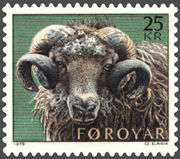
Domestic sheep are sometimes used in medical research, particularly for researching cardiovascular physiology, in areas such as hypertension and heart failure. Pregnant sheep are also a useful model for human pregnancy, and have been used to investigate the effects on fetal development of malnutrition and hypoxia. In behavioural science, sheep have been used in isolated cases for the study of facial recognition, as their mental process of recognition is qualitatively similar to humans.
Cultural impact
Sheep have had a strong presence in many cultures, especially in areas where they form the most common type of livestock. In the English language, to call someone a sheep or ovine may allude that they are timid and easily led, if not outright stupid. In contradiction to this image, male sheep are often used as symbols of virility and power, such as for the St. Louis Rams and the Dodge Ram. Sheep are key symbols in fables and nursery rhymes like The Wolf in Sheep's Clothing, Little Bo Peep, Baa Baa Black Sheep, and Mary Had a Little Lamb. Novels such as George Orwell's Animal Farm, Thomas Hardy's Far From the Madding Crowd and Three Bags Full: A Sheep Detective Story utilize sheep characters or plot devices. Poems like William Blake's " The Lamb", songs such as Pink Floyd's " Sheep" and Bach's aria Sheep may safely graze (Schafe können sicher weiden) use sheep for metaphorical purposes. In more modern popular culture, the 2007 film Black Sheep exploits sheep for horror and comedic effect, ironically turning sheep into blood-thirsty killers.
Counting sheep is popularly said to be an aid to sleep, and some ancient systems of counting sheep persist today. Sheep also enter in colloquial sayings and idiom frequently with such phrases as " black sheep". To call an individual a black sheep implies that they are an odd or disreputable member of a group. This usage derives from the recessive trait that causes an occasional black lamb to be born in to an entirely white flock. These black sheep were considered undesirable by shepherds, as black wool is not as commercially viable as white wool. Citizens who accept overbearing governments have been referred to by the portmanteau neologism of sheeple. Somewhat differently, the adjective sheepish is also used to describe embarrassment.
In religion and folklore
Religious symbolism and ritual involving sheep began with some of the first faiths: skulls of rams (along with bulls) occupied central placement in shrines at the Çatal Hüyük settlement in 8,000 BCE. In Ancient Egyptian religion, the ram was the symbol of several gods: Khnum, Heryshaf and Amun (in his incarnation as a god of fertility). Other deities occasionally shown with ram features include: the goddess Ishtar, the Phoenecian god Baal-Hamon, and the Babylonian god Ea-Oannes. There are also many ancient Greek references to sheep. The god legend of Chrysomallos the golden-fleeced ram continues to be told through the modern era.
Sheep play an important role in all the Abrahamic faiths; Abraham, Isaac, Jacob, Moses, and King David were all shepherds. Sheep are also the first animals mentioned in the Old Testament. According to the story of the Binding of Isaac, a ram is sacrificed as a substitute for Isaac after an angel stays Abraham's hand. Eid ul-Adha is a major annual festival in Islam in which sheep (or other animals) are sacrificed in remembrance of this act. Greeks and Romans also sacrificed sheep regularly in religious practice, and Judaism also once sacrificed sheep as part of the Korban. Ovine symbols—such as the Passover lamb and the ceremonial blowing of a shofar—still find a presence in modern Judaic traditions. In Christianity, a congregation is often referred to as a flock, and sheep are an element in the Christian iconography of the birth of Jesus. Christ is also portrayed as the Sacrificial lamb of God ( Agnus Dei) and Easter celebrations in Greece and Romania traditionally feature a meal of Paschal lamb.
Astrologically, the ram is the first sign of the Western zodiac, in which it is known as Aries. The sheep is also the eighth of the twelve animals associated with the 12-year cycle of in the Chinese zodiac, related to the Chinese calendar. Sheep were not eaten in Madagascar as they were believed to be incarnations of the souls of ancestors.
